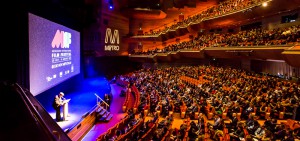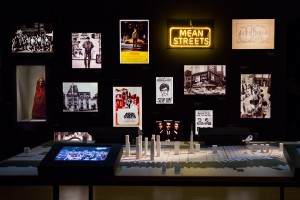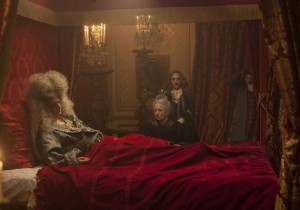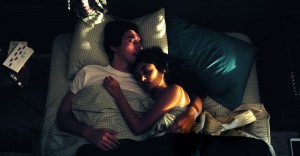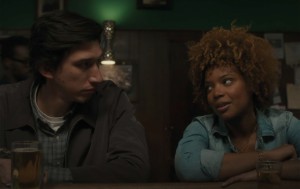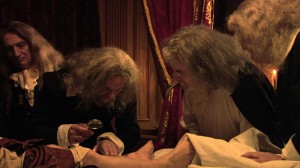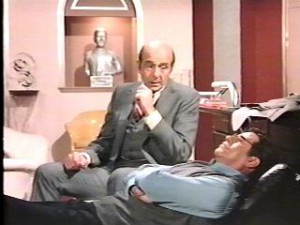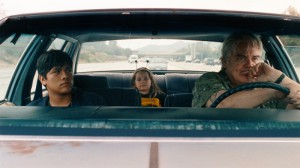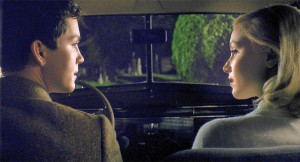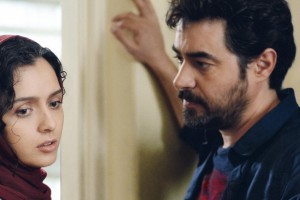Written for Film Comment‘s web site in mid-August 2016. — J.R.
Although it isn’t widely recognized, Melbourne’s historical status as the cradle of online film criticism — as signaled by the founding of Screening the Past in 1997, Senses of Cinema in 1999, and Rouge in 2003 — remains a significant part of its film culture, so highly developed and serious that not once, during fourteen festival screenings, did I ever notice any viewers activating their mobiles. It’s equally evident that the pioneering web sites which helped to foster this kind of seriousness were neither accidental nor coincidental. All three were calculated gestures of outreach from a remote outpost to the rest of the world — allowing everyone a glimpse into a literary culture and a branch of cinematic savvy unhampered by the twang of regional accents or the pressure of imminent local releases. And as outreach gestures they no less clearly succeeded and flourished — so well, in fact, that their innovations and energies were quickly absorbed into the Internet mainstream without leaving behind many telltale markers of where they’d been nurtured. (If the Internet sometimes fosters historical blindness, this is especially true of the Internet’s own history.) Above all, the kind of criticism practiced by these three influential sites avoids the thumbs up/thumbs down reflexes of market-driven criticism for the sake of more open-ended discussions, closer to the example offered by Manny Farber (whose reviews could rarely if ever be quoted in ads) than to those of the Siskel-Ebert or Rotten Tomatoes persuasion.
It isn’t surprising that Michelle Carey, artistic director of the Melbourne International Film Festival (Australia’s largest and oldest, founded in 1952), remains one of the key editors at Senses of Cinema, after many years of managing its burgeoning Great Directors section. Earlier this year, she invited me to participate as one of the eight mentors (five of them women) to eight young Australian film critics (six of them women) at the Critics Campus, a weeklong lab of workshops and panels launched at the festival three years ago. Many of the panels brought up the issue of how film criticism can be sustained in a climate where it’s become almost impossible to make a living at it — a legitimate concern, although one could also argue that its increasing detachment from the film business has allowed for a certain existential and intellectual purification whereby film criticism practiced for its own sake can be a freer and even more dedicated activity than professional reviewing.
The critical bent of much of Carey’s programing, including the panels I attended as a witness or participant, was particularly striking. One of the more ambitious sidebars, “Gaining Ground,” focused on New York women filmmakers in the 70s and 80s: Lizzie Borden, Kathleen Collins (whose recently restored 1982 Losing Ground prompted the series’ title), Sara Driver, Elaine May, Susan Seidelman, and Claudia Weill. And in tandem with a Jerry Lewis retrospective was a truly remarkable panel that virtually invented a new form of film criticism which might be termed performative: four Australian comedians (Shaun Micallef, Santo Cilauro, Frank Woodley, and Lawrence Mooney) who know Lewis’s strategies, moves, and vocal inventions and inflections so precisely that they could deftly reproduce them to illustrate their various points, complemented by Chris Fujiwara’s astute observations.
The least critical (or, rather, the most uncritical) of the festival sidebars was a massive exhibition at the Australian Museum of the Moving Image (also one of the screening venues) entitled “Scorsese” that has been touring the world and didn’t originate in Australia. I must admit that I was already somewhat biased against the show as soon as I saw Travis Bickle dolls and “You talkin’ to me?” T-shirts for sale in the Museum’s souvenir shop, both of which brought back my sense of Donald Trump’s endless speech at the Republican National Convention having been punctuated throughout by Bickle’s body language, constipated grimaces and all. (It was cheering, however, to learn from Melbourne friends and a couple of local newspapers that Trump is relatively unpopular even among Australia’s racist and rightwing factions.) But the exhibition itself — a vast array of storyboards, props, costumes, letters from famous people which aren’t necessarily interesting to read, and other memorabilia — was basically a well-mounted assembly of fanboy collectibles rather than anything offering either critical guidelines or illuminating pointers towards the films themselves.
By way of immediate contrast, I have to thank Jessica Ellicott — the Sydney-based critic for the online 4:3, whom I was mentoring at the Critics Campus — for altering my own critical relation towards one of the festival films she wrote about, Robert Greene’s Kate Plays Christine. This is a curious mix of non-fiction and fiction about a real actress (Kate Lyn Sheil) preparing to play a real person (Christine Chubbick, the Orlando reporter who notoriously shot herself on live TV in 1974) in an imaginary film. What blocked any positive response from me towards Greene’s film was its testy baiting of my imagined responses, which reminded me of Michael Haneke’s original Funny Games (I stayed away from his remake) in its glib assumption that I was eagerly awaiting the violence that his story seemed to promise. But Ellicott’s review, available here (along with three other interesting reviews by other Critics Campus participants), alerted me to the film’s theoretical dimension: “One major effect of Kate Plays Christine is to provoke discussion about aspects of authenticity, performance and ethics in documentary, expanding on the themes of Greene’s previous film Actress (MIFF 15)” — although her review concedes the film’s problematic nature by concluding with a question: “Is it possible to embrace a film that seems to reject itself?”
***
Ending a review with a question rather than a judgmental, market-driven conclusion is one of the tendencies of online criticism that I most value — the desire to offer not the first or last word on any given film but to spark or widen an ongoing discussion about it. This becomes a lot easier to do if you’re based in somewhere like Australia and addressing the world outside as well as within its borders, where conforming to the release dates of other territories isn’t a likely option. And to honor this tendency, I’d like to try to follow Ellicott’s example by “reviewing” a couple of the other festival films I saw in Melbourne, probably my two favorites, in a similarly nonconclusive fashion. In both cases, these are first impressions that might be modified by subsequent viewings.
Let me start with Jim Jarmusch’s Paterson, the first film I saw in Melbourne, which arrived festooned with Cannes buzz, both positive and negative, about its approaches to everyday American life and to poetry. The sticking point for some is that everyday American life is generally felt to be actively hostile towards poetry of any kind. As Jarmusch once said to me in an interview, “You go out to fucking Wyoming and go in a bar and mention the word poetry, and you’ll get a gun stuck up your ass. That’s the way America is. Whereas even guys who work in the street collecting garbage in Paris love nineteenth-century painting.” This is what makes the central tenet of Paterson so provocative: the notion that everyday American life is not only imbued with poetry, but enhanced by the fact that all Americans are artists of different sorts, whether they know it or not — not just the film’s eponymous bus-driver poet and hero (Adam Driver) and his beloved Iranian housewife Laura (Golshifteh Farahani), who know that they’re artists, but also the crazy fool in a bar who pretends to shoot himself with a toy gun and the barkeeper whose spare time is dominated by his preoccupation with chess, who seemingly don’t know that art is what they’re practicing and living by. Moreover, these people and virtually everyone else in Paterson tend to practice art for its own sake rather than for profit or recognition. Even the main couple’s pet bulldog winds up producing a kind of radical punk art, which ultimately lands him in the doghouse (i.e. garage).
One of the gifts that Jarmusch offers critics, which he shares with such giants as Chaplin and Hitchcock, is his paradoxical capacity to make every new work seem like a departure while remaining completely characteristic, largely by creating dialectical relationships to his previous works. Thus the relatively cryptic and alienated/alienating The Limits of Control can be read as a response to the mainstream address and success of Jarmusch’s previous Broken Flowers, and the populist, proletarian romantic couple in Paterson counters the elitist, aristocratic romantic couple in Only Lovers Left Alive, meanwhile recapitulating some of the minimalist strategies of Coffee and Cigarette and offering a contrast to the cadenced, rhetorical poetry of William Blake in Dead Man with the plainspoken and more prosaic model of poetry offered by William Carlos Williams.
Speaking as someone who found the elitism of Only Lovers Left Alive somewhat off-putting, and the specimens of stylish elegance in Paterson (such as Ohio Blu-Tip matches) more seductive than those in the previous film (such as the postmodernist guitars), I find the populism of Paterson refreshing. But I wish it were a little more egalitarian in its respective treatments of male and female as well as black and white characters. Maybe they’re all artists worthy of our affection and respect, but I wish Jarmusch and his hero were a little less patronizing towards Laura’s decorating and musical skills and the black characters’ seeming lack of awareness of their own artistic bents. These are quibbles about nuance, less relevant if one grants Jarmusch the same poetic license he generously grants to others, because the daffy overriding notion of a downscale U.S. composed exclusively of artists transcending their banal lives with their own compulsive creativity is hard to resist. Whether this is because I actually believe in this conceit or because I would like to is a thorny question that I’m still trying to resolve.
Paterson was the film in Melbourne that I’d most looked forward to seeing; I approached Albert Serra’s La mort de Louis XIV with a good deal more trepidation. Having been both intrigued and bemused by Serra’s minimalist 2006 Don Quixote demystification, Honor de Cavelleria, and then bemused and bored by his 2008 minimalist demystification about The Three Wise Men, Birdsong (as well as by Mark Peranson’s “making of” documentary about the latter, Waiting for Sancho), I’d skipped Serra’s subsequent work through a combination of circumstance and inclination. But the prospect of seeing Jean-Pierre Léaud as Louis XIV, which struck me as a spectacular form of miscasting, piqued my curiosity, allowing me to speculate that maybe I hadn’t yet figured out what Serra was up to, and it was delightful to discover how wrong I was about the casting and how right I was about my speculation. Perhaps the only thing that Don Quixote, The Three Wise Men, and Louis XIV have in common is their status as myths, and offering earthier versions of those myths now appears to be only one facet of Serra’s ambitious agenda.
Indeed, given its almost exclusive focus on the bedside of a dying, monosyllabic king, and the inanity of most of what gets said by those in attendance around him, I was amazed to find that The Death of Louis XIV was easily the most gripping film I saw in Melbourne, surpassing even Paterson and Jerry Lewis’ Smorgasbord/Cracking Up in this respect (and perhaps in its comedy as well, even though Serra’s humor is obviously much quieter and dryer than Jarmusch’s or Lewis’s). Much as certain novels can be described as page-turners, this film is incontestably a frame-turner, and the mystery of figuring out why this is so comprises only part of its fascination. Léaud’s exquisite and convincing minimalist performance is only one aspect of this concentration. One counterpart that comes to mind is Tsai Ming-liang’s Goodbye Dragon Inn (2003), which I saw twice with similarly packed film-festival audiences in Toronto and Chicago, and both times, during a shot of an empty cinema auditorium where nothing happens for over two minutes, you could hear a pin drop. The same sort of hush presided over the packed Melbourne audience for Serra’s film, where again nothing much happens for most of the running time.
As in the films of Stroheim, the sheer intensity of what one experiences throughout is obviously attributable to some alchemical blend of writing, directing, photography, costume and set decoration, and performance, but how these come together so seamlessly and so forcefully is much harder to fathom, except in rhetorical and auteurist terms such as “will” and “vision”. I have no idea what Serra thinks of Roberto Rossellini’s fascinating 1966 La prise de pouvoir par Louis XIV, assuming that he’s seen it, but suspect that the two films would make an ideal double bill. They both constitute historical explorations in which the shots figure more as perpetual questions than as answers.
***
As I argued in one of the Melbourne panels, the very notion that films can be labeled “good” or “bad”, so basic to mainstream reviewing protocol, becomes nonsensical unless one provides some context: good or bad for what, and for whom? I can’t imagine any film qualifying as either good or bad for everything and for everyone, so the deployment of these adjectives without stated qualifiers presupposes a universality of values and uses, even though it’s paradoxically addressed in most cases to a particular market and audience that implicitly excludes others.
From this standpoint, I’d like to conclude by turning to some of the other films I saw in Melbourne, none of which I can either embrace or reject. I would describe Werner Herzog’s documentary Lo and Behold: Reveries of the Connected World as useful for its broaching of Herzog’s grumpy demurrals about the Internet and its history and almost completely uninteresting in all other respects. Rafi Pitts’ Soy Nero, for me a disappointment after the brilliance and power of his 2010 The Hunter, is valuable for its exposure of the tragic dilemma of illegal Mexican immigrants who enlisted in the American army to gain citizenship and wound up getting deported anyway; it also has many striking things to impart about how the U.S. appears to such a person and to other displaced exiles, including Pitts himself. It’s a credit to James Schamus’s Indignation that it makes me want to read the Philip Roth novel it adapts, even though I’m not much of a Roth fan; it seems to offer at times an intriguing tug of war between Schamus’s mainstream efforts as an Ang Lee producer and his more academic impulses as a Carl Dreyer enthusiast. André Téchiné’s Being 17, about a troubled gay teenage relationship in rural France, shows plenty of evidence of its director-cowriter’s sensitivity and passion, yet for me it pales alongside such explosive earlier features as Wild Reeds (1994), Thieves (1996), and Unforgivable (2011). And Asghar Farhadi’s The Salesman adeptly showcases his commercial skill in extracting moral nuances from his carefully calibrated storytelling, once again privileging a woman’s viewpoint without ever quite sharing it or exploring it.



